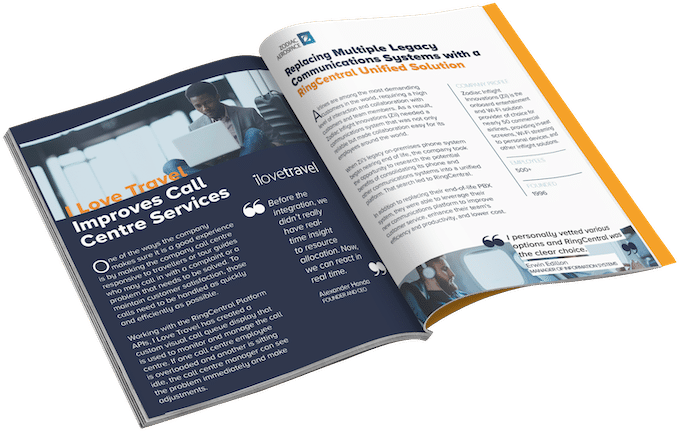Flexible working is on the rise. Notions of a three-day weekend, or a lengthy lunch break used to be the stuff of dreams. But these dreams are very much becoming reality. More and more companies are transitioning to hybrid work arrangement and flexible working models in order to improve employee work-life balance, wellbeing, and foster a more adaptive working environment.
But hold on for a moment. Let’s get something straight. Flexi-work is still working. Flexible working doesn’t mean working less and playing more. Rather, it means working more when it’s convenient for you to work more, and less when you have other pressing responsibilities.
Flexible work options have been a long time coming. Did you know that over 52% of Londoners could be doing their jobs remotely? But to start making real change, the right tools are key. As businesses embrace flexible working options more readily, they’ll need to unify their communications.
Luckily UCaaS providers (Unified Communications as a Service) offer services to make multi-platform, internet-based team and customer communications simple. With that in mind, let’s delve into the world of flexible work in more detail.

Photo by Andrew Neel on Unsplash
What is flexitime?
You’ve probably heard the words ‘flexitime’ and ‘flextime’ being thrown around a lot in recent years. More and more, it’s becoming an accepted part of working life. Flextime is the word commonly used to describe a flexible work policy. All that means is a work policy that allows employees to choose their own work hours.
This is how it works. An employer will allow their employees to alter the start or end time of their workday. They could also adjust break times. As long as the employee works their scheduled working hours, just as they would under a traditional schedule, the precise window of time spent working is up to the employee.
Flextime is not about working less. It’s about working smart. Working flexibly. Typically, flextime arrangements look a little something like this:
- Personalised core hours applicable Monday to Friday.
- Set weekly hours quota with personalised start and finish times each day.
- Varying workday duration, or fewer days, with set weekly hours quota.
- Longer workday with an extended lunch period.
- Shorter workday with a shorter lunch period.

Image by Morgan McKinley
Some employers will offer more workplace flexibility than others. The idea is to make working life easier on our hectic schedules. Flextime recognises that lots of people are juggling multiple responsibilities and accommodates for that.

Perhaps you have a long commute or need time to pick your children up from school. There are lots of scenarios in which flextime works its magic. It’s no wonder that it’s become one of the most popular employee benefits on offer. People want flexible working options that complement their lives.
Flexible working promises employees a better work-life balance and offers employers happier employees. It’s a win-win for all. Employees are less likely to reach burnout and more likely to stay in a company as a long-term employee.

Image by EtsPlc
Of course, flexitime isn’t the only type of flexible working on offer. Other options include:
Remote work/ telecommute
This is a great option for employees that want to save on commuting time and costs. If the employee’s job doesn’t require them to be on-premises all, or some, of the time, then employers could consider giving them the option to work from home (or closer to home). Many hybrid work solutions involve remote working for part of the week, and in-office working for the rest.
This takes the pressure off the employee and could even cut a business’ real estate expenditure by downsizing office-space. Needless to say, less commuting also does wonders for lowering your carbon footprint.
According to a study by Nemertes Research, Prior to 2020, 59% of contact centres around the world enabled some of their staff to work from a home. After the outbreak of coronavirus, that rose to a staggering 74.1%.
2020 has only heightened the world’s attention on remote work. The convenience of this set-up is becoming increasingly recognised as a legitimate and productive way to mobilise certain industry workforces. Luckily, integrated, omnichannel communications are now widely available. With the right tech in place, remote working can be a straightforward and efficient way to manage workflows and foster flexibility.

Photo by Standsome Worklifestyle on Unsplash
Staggered work hours/shift work
When we think of shift work, our minds usually turn to the factory or manufacturer. But shift work has the potential to work in other work environments as well. As more services in our globalised, internet-based, economy require 24/hour operations, shift work has entered the world of commerce and customer service. Thanks to flexible working options this is now possible as workforces are spread throughout different hours of the day, days of the week, and locations all across the globe.
Job sharing
Job sharing is when two part-time work employees share the responsibilities of one full-time job. This is a great way for companies to attract applicants from a much more extensive pool of potential candidates. It’s also an effective option for existing employees who might not be able to commit to full-time hours due to lifestyle changes. Instead of losing employees, companies can increase retention with flexible job share arrangements.

Image by Statista
Compressed workweek
A compressed workweek is a type of flexible scheduling. Employees on a compressed workweek contract continue to work their standard 40-hour week but in a compressed period of time. They might choose a four day week or spread their working days out across a two week period. That means the three day weekend really is possible. You’ll just have to put in a few extra hours the rest of the time. The compressed workweek tends to be a favourite for parents in need of parental leave and carers with additional responsibilities.
Flextime in Practice
Flextime used to be somewhat unconventional but those days are gone. 55% of Morgan McKinley survey respondents admitted to no longer viewing flexible working as an additional benefit but as an expectation when looking for a new job.
This method of fluid working comes with a required commitment from both sides. Flextime is still a structured process. Employees interested in exploring their flexible working options will need to go through the appropriate protocols as set out by their workplace.

Image by Statista
Requesting flextime
Requesting flextime need not be stressful. Many employers support this initiative and will be happy to discuss flextime options with their employees. Even if they don’t have a policy in place, it can be worth asking. The process usually goes something like this:
- The employee initiates flexible working requests.
- Employees submit a formal proposal to their department lead.
- Department leads decide whether to approve the proposal.
- If approved, flextime will be initiated for a trial period.
- If successful, a flextime arrangement will be drawn up.
The flextime trial period is designed so that employees and employers have an opportunity to see if flextime works for them. The employee is free to opt-out at any time. Similarly, if employee performance on the new flextime schedule is not up to par, the department lead reserves the right to suspend the agreement on the basis of employee performance or operational needs.

Photo by Gabrielle Henderson on Unsplash
Flextime responsibilities
After a successful flextime trial, a time-specific contract will be written up and filed as part of the employee’s official records. The agreement comes with certain responsibilities for both parties involved. The employee must work the hours as agreed upon in the flextime working contract.
The employer must remain communicative and answer employee concerns as necessary. It is also the responsibility of said employer or department lead to make sure that the employee continues to work the normal workweek hours under the new flextime routine.
Flextime isn’t always appropriate
Flextime will not be a feasible option for everyone. Sometimes a business’ operational, staffing, or logistical needs just aren’t able to support flextime contracts. Flextime only works when it doesn’t negatively impact the people around you, your coworkers, and company workloads.
If you work in an industry in which flextime isn’t offered, or if your company has reached its flextime quota, don’t worry. There are other flexible working options available- intermittent flextime, for example, or seasonal working hours.
Pros and Cons of Flexible Work Arrangements
Changing up workplace culture and routines can feel like a mammoth task. But with flextime growing in popularity, it’s got to be worth trying. Right? To create a clearer picture, let’s take a look at some of flextime’s best, and not so great, features.
Flextime: the pros
Flextime offers employees the freedom to find that all-elusive work-life balance. At the end of the day, that’s what flextime is all about. Something about the traditional nine to five working day just wasn’t working. So what makes flextime so much better than standard nine to fives?

Photo by Ryan Tang on Unsplash
1. Freeing up family time
Flextime acknowledges that most working people have other commitments besides their job. People need to pick up and drop off their kids at school, for example. Others might have second jobs to get to, difficult commutes, or caring responsibilities. Instead of letting employees suffer unnecessarily, flextime allows them to work in a way that is more efficient and well-suited in the context of their own, unique, lives.
2. More motivation
In general, feeling trusted increases a person’s motivation and commitment to a role. By offering employees flexibility, you’ll foster a happy, positive workplace. Employees will be able to work where and when they are most productive. Did you know that 61% of people feel that they work more efficiently in the morning? And a happy workplace means less absenteeism, more enthusiasm, and better working relationships.

Image by Statista
3. Options
Flextime gives people options. It gives companies options and it gives employees options. There’s no one way to do flextime right. Flextime comes in many forms. This gives companies and employees the opportunity to create something uniquely theirs, and that supports their particular needs. That could mean anything from job sharing to remote working, to seasonal working hours. The possibilities are endless.

4. Mutually beneficial
One of the nicest things about flextime is that its benefits are a two-way street. In other words, flextime can be just as good for employers as it is for employees. By making employees working lives as simple as possible, employee turnover naturally decreases. When recruiting employers will start to attract talented candidates who might previously have disregarded the role due to logistical or lifestyle-related constraints.
5. Increased coverage
Flextime schedules have some positive “side-effects.” A flextime work schedule often inadvertently allows a company to increase the coverage of its services beyond standard working patterns. Because different employees are working at different times, organizations can staff their services over a longer period of time without having to fork out for overtime payments.

Image by Buffer
Flextime: the cons
Flextime does seem like a very attractive package. And it is. But it’s important to make yourself aware of any possible negative consequences before deciding whether it’s the solution for you. Nothing in life is perfect and, for some businesses and employees, neither is flextime. Possible disadvantages associated with flextime include:
1. Complicated communications
When teams aren’t all together at once, communications can become slightly trickier. Working different hours means people won’t always be available when you need them. Transitioning to flextime working models requires a great amount of prior planning and preparation to make sure communications and workflows can continue as close to normal as possible.
One of the best ways to overcome this obstacle is to mobilise the right technology. RingCentral helps organizations switch from traditional landlines to remote, cloud-based communications, to make flexible working much more straightforward. It allows employees to communicate within teams, and with customers, from wherever they happen to be. That means even if teams aren’t together in the same room, they can still maintain the same, if not better, level of communication.

Image from RingCentral
2. Supervision
When a team is dispersed, supervision becomes a bit more tricky. Flextime requires employers to place a lot of trust in their employees. Since management staff will usually continue to work a traditional nine to five, 40-hour week, employees on flextime will not be under their watch all of the time anymore.
This lack of supervision could result in a lack of compliance from some, less-motivated, employees. Similarly, with the workforce dispersed, there might not always be the right person on hand to answer very specialised customer questions as and when they arise.
3. Increased costs
Facilitating non-conventional working hours could increase some costs. Utilities, for example, will have to be in operation for more hours of the day than previously. They might even need to be rolled out 24 hours a day. That doesn’t come cheap. Especially for small and medium-sized businesses, these costs could jeopardise profits.
Of course, this is not always the case. It depends largely on the type of flexible working options your business is rolling out. Flexible remote working, for example, bypasses soaring utility bills. The financial implications of hybrid working options will depend largely on your individual business and whether it is onsite or remote.
4. Time management
But isn’t the whole point of flextime to make time management better? Good question. Yes, in one sense it is. But flextime can also create problems when it comes to scheduling meetings, seminars, workshops, and team-building activities.
This means that flextime office environments must be extremely organised and mobilise the necessary technologies to make sure collaborative activities do not suffer as a consequence. Work management tools like time trackers and other business software can be a real help when it comes to workforce time management and establishing appropriate working conditions.

Tips for Implementing Flexible Work Arrangements
Flexible working is definitely here to stay. Employers need to brace themselves for this new normal once and for all. Flexwork has the potential to be hugely rewarding for employers and employees alike. Here are some top tips for implementing flexiwork successfully.
Think big-picture
Don’t dive in at the deep end. Start by considering some important questions so that when you do give flexiworking the go-ahead, the policy change goes as smoothly as possible. Think about all the possible implications flexiwork could have for management, Human Resources, client relationships, employees, finances, training, and management workloads.
Talk to your team
Sit down with your team and see what they think. By knowing the needs of your staff, you’ll be in a much better position to implement and run out a flextime policy that actually works. Have one-to-one conversations, conduct focus groups, surveys, and discussions. You never know what great ideas they might come up with. By opening up communication you’ll also generate enthusiasm for this new initiative as it develops further.

Photo by LinkedIn Sales Navigator on Unsplash
Don’t skip the trial period
It might feel tempting to just get cracking but conducting a trial period is so important. Before implementing any new policy, especially one that involves intense structural change, running a pilot scheme is the next step. During and after the trial period, conduct employee evaluations to gauge the trials success and identify any stumbling blocks. You wouldn’t send a product straight to market so don’t implement a new workplace culture without a successful prototype first.
Invest in Relevant Software
Don’t run a flexible working policy out without the right tools in place first. For flexible working to succeed (especially for companies adopting telecommuting and home working options) communication channels need to be top-notch.
Online communications will be key to streamline any flexible workforce. There are lots of internet and cloud-based communications options out there today, designed to help streamline workflows without the need for in-house hardware.
RingCentral provides modern business communications for small teams. RingCentral’s small business solutions can be set up in minutes and offer holistic communications solutions. So what does an all-in-one communications solution look like?
Well, it integrates messaging, video, and phone together via the internet ensuring all your work can be done seamlessly via one multifunctional application. Plus, RingCentral communications integrate with hundreds of popular tools like Office 365, G Suite, and Salesforce.
By investing in relevant software your SMB will reap the rewards. Benefits include:
- Working together from anywhere
- No more app switching
- Information tracking
- Data protection
- Reliable connectivity
Best Practices on Flexible Work Arrangements and Policies
So, the trial period is over and the office is now a bonafide flex work establishment. You’ve done all the right things to get to this point, but how can businesses and employees nurture best practices for flexible working arrangements and policies in the long-term?
The answer? Prior preparation and careful planning. To keep operations running smoothly it’s important to have some things in place.

Photo by Scott Graham on Unsplash
A unified procedure
When employees start requesting modifications to their work schedules under a new flexi-scheme, it’s important to have a unified written proposal in place for applicants to fill out. This will provide a clear set of guidelines and criteria for flexible-working eligibility and make it easier for senior management to grant or deny flex work approval to employees fairly.
Clear guidelines
Employees should provide clear goals and objectives for their employees. When working life becomes more flexible it’s important to retain a sense of order. Providing goal-oriented expectations is an effective way to keep teams motivated inside, and outside, the office.
Some examples to consider:
- Give employees clear deadlines
- Ask employees for scheduled productivity summaries
- Maintain formal and informal employee check-ins
- Lay out clear expectations for response times
Make all objectives specific and measurable, wherever possible. By establishing these objectives in policy terms, employees will have tangible performance evaluation methods by which to assess employees and the flexible work scheme more generally.
Review and modify
Engage in regular reviewing activities. Just because the trial period is over, it doesn’t mean that your flexible working policy is perfect. As more employees start taking up flexible working, continue monitoring their progress. Conduct reviews on a regular basis, and make adjustments as necessary. All new policies will need time to settle in and find their groove. Give it time and try to review bi-annually at a minimum.

Image by MorganMcKinley
The future is flexiwork
The desire for flexible working options has been on everyone’s minds for some time now. As more and more employees seek flexible working options that fit around their busy, modern lives, establishing work practices to match is now a necessity.
To facilitate a flexible working lifestyle, mobility is key. Business plans should now prioritise mobility to ensure organisational continuity. Implementing flexible and hybrid working now can help keep your business an attractive prospect to new applicants, as well as bringing out the best from your current employees.
Originally published Feb 15, 2021, updated May 07, 2021




